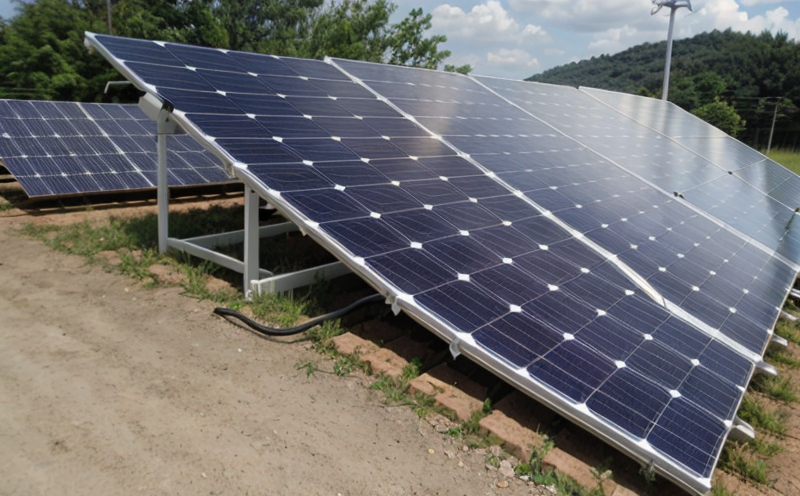IEC 61853-3 PV Module Power Rating under Different Conditions
The International Electrotechnical Commission (IEC) IEC 61853-3 specifies the procedures for determining the power rating of photovoltaic (PV) modules in different environmental conditions. This is a critical step in ensuring that PV systems meet performance expectations under real-world operating conditions, which can vary significantly from standard test conditions.
The IEC 61853-3 test involves measuring the power output of a solar panel or module at various temperatures and irradiances. The goal is to determine the maximum power point (MPP) voltage and current under these varying conditions, as well as other key performance parameters such as short-circuit current (Isc), open-circuit voltage (Voc), and fill factor (FF).
The test setup typically includes a solar simulator or a natural sun source, along with a high-precision power meter to measure the output power. Environmental chambers are used to control temperature and irradiance levels accurately. The specimen preparation involves ensuring that the module is clean and free from defects prior to testing.
One of the key challenges in this test is simulating real-world conditions. This can be particularly difficult for modules exposed to extreme temperatures or high levels of dust, sand, or snow. The test must account for these factors by adjusting irradiance levels and temperature gradients. For instance, under low-light conditions, the solar panel's power output will decrease significantly.
The results of this test are crucial for several stakeholders:
- Manufacturers can use the data to optimize module design and improve efficiency.
- Eurocodes and building codes may require compliance with certain power ratings under specific environmental conditions.
- Grid operators need accurate performance data for grid integration purposes.
- R&D engineers can use the test results to refine their models and improve future iterations of solar technology.
The accuracy of the power rating is essential, as it directly impacts the energy yield of a photovoltaic system. A poorly rated module could lead to underestimating its performance, resulting in financial losses for investors or increased costs for consumers. On the other hand, overestimation can result in unnecessary expenses and inefficiencies.
The IEC 61853-3 test is particularly important for large-scale solar installations where even small inaccuracies can have significant economic implications. For example, a 1% deviation in power rating could translate to thousands of dollars in lost energy over the lifetime of a project.
Applied Standards
| Standard Number | Description |
|---|---|
| IEC 61853-3 | Determination of the power rating of photovoltaic (PV) modules under different conditions. |
| ASTM E2479 | Standard test method for determination of the temperature coefficient and other electrical parameters of photovoltaic devices. |
| Test Parameters | Description |
|---|---|
| Irradiance Levels | The test requires measuring power output at different irradiances, typically ranging from 400 W/m² to 1000 W/m². |
| Temperature Gradients | Temperature is varied between -25°C and +85°C to simulate real-world conditions. |
| Environmental Factors | Includes dust, snow, and other environmental impacts that can affect module performance. |
Why Choose This Test
The IEC 61853-3 PV Module Power Rating under Different Conditions test is essential for ensuring the accuracy of power ratings, which in turn impacts the overall performance and reliability of solar systems. By measuring the module's output under various conditions, this test provides a more realistic assessment than standard laboratory tests.
For manufacturers, this test helps identify any potential issues with their products before they reach the market. It also allows them to optimize their designs for better performance in different environments. For installers and operators, accurate power ratings are crucial for proper system sizing and energy yield estimation.
The test is particularly important for regions with diverse climates, such as those with extreme temperatures or high levels of dust and sand. In these areas, the standard laboratory tests may not accurately reflect real-world performance. The IEC 61853-3 test ensures that modules perform optimally under a wide range of conditions.
From an environmental perspective, accurate power ratings contribute to more efficient use of renewable energy resources. This helps reduce reliance on fossil fuels and contributes to global sustainability goals. Accurate performance data also enhances the credibility of solar projects, making them more attractive to investors and stakeholders.
Competitive Advantage and Market Impact
The IEC 61853-3 PV Module Power Rating under Different Conditions test provides significant competitive advantages for companies operating in the renewable energy sector. By ensuring accurate power ratings, manufacturers can differentiate their products from competitors by offering more reliable and efficient solar panels.
Accurate performance data also enhances the reputation of a company among customers and stakeholders. This can lead to increased market share and better customer satisfaction. For example, a company that consistently provides high-quality, accurately rated modules is likely to be preferred over one with less accurate ratings.
The test's impact on the market extends beyond individual companies. By ensuring that all solar panels meet the same rigorous standards, the industry as a whole benefits from increased confidence in renewable energy technologies. This can lead to broader adoption of solar power and greater investment in clean energy projects.
From an economic perspective, accurate power ratings help reduce costs associated with overestimating or underestimating module performance. For investors, this translates to more reliable returns on their investments. For consumers, it means better value for money when purchasing solar systems.





